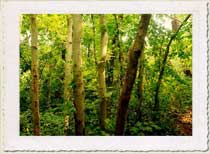
Conference House Park Preserves
Borough: Staten Island
Acres: 105
Habitat Type: Forest, Freshwater Wetland
Long before Europeans settled this land on the southernmost tip of Staten Island, there was a strong Native American association with this site. The Lene Lenape Indians used this area, particularly the bluff, as a seasonal settlement. They traveled up and down the East Coast from the New York Harbor to the Delaware River basin, oystering, fishing, hunting, and trading. At one time, animals such as deer, turkeys, heath hen, black bears, beavers, wolves, red and gray foxes were plentiful in this region.
Today, there is still a variety of life to see when visiting the park. Every May and June, horseshoe crabs (Limulus polyphemus) emerge from the Arthur Kill and Raritan Bay onto the beaches of Conference House Park. The horseshoe crab has been around since before the dinosaurs, roughly 1.2 billion years, and is referred to as a “living fossil”. Female horseshoe crabs arrive on the beaches to lay their eggs, with their male counterparts grasped onto the back of the female’s shell. Two weeks later the eggs are ready to hatch and the water sweeps the newborns into the sea. The thousands of protein-rich eggs provide a feast for hungry migrating birds, which can eat enough to double or even triple their body weight before moving on.
Starting in late June, visitors to the south-facing shorelines of Conference House Park can often enjoy a glimpse of monarch butterflies (Danaus plexippus) as they travel through the city. The monarch butterfly lay their eggs on milkweed (Asclepiadaceae) plants and die, entrusting their offspring to fend for themselves. As the larvae gorge themselves on the milkweed leaves, they accumulate the milkweed’s toxic cardiac glycosides and become poisonous to birds and other predators. Monarch butterflies from New York City begin migration in September and travel as much as 2,100 miles to reach their winter destination in central Mexico, in the state of Michoacan, by the end of October.
One of the most common sights in the park are common reeds, or phragmites, a member of the grass family. They thrive in both brackish and fresh water marshes, and can grow to be 12 feet tall. Phragmites often invade wetlands at the expense of other native marsh plants.
Directions
Public Transit: From ferry, take the S78 bus to the end of Hylan Blvd.
By Car: Take the Verrazano Bridge to the S.I. Expressway (Route 278) to exit 5 (NY-440 S via toward the Outerbridge Crossing). Take exit 3 towards Bloomingdale Road. Take a left on Bloomingdale Road and proceed about 1.5 miles until it becomes Amboy Road. After about 1.3 miles, take a left on Page Avenue, then take the 4th right onto Hylan Boulevard. Park is at the end of Hylan Boulevard.
